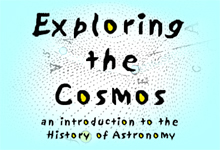

Department of History
University of California, Irvine
Instructor: Dr. Barbara J. Becker
![]()
Lecture 3. A Matter of Aesthetics.
![]()
Transmission of Ancient Knowledge in Western Europe from the Fall of Rome (5th c CE) to Pre-Renaissance (12th c) |
|
|
| Goals:
standardizing and preserving Christian dogma
preserving and practicing Christian lifestyle
|

Monk at work in the Scriptorium |
|
|
|
|
|
|
|
| Plato |
|
|
|
| Aristotle |
|
|
|
| Lucretius |
|
written in Latin |
|
|
|
|
Transmission of Ancient Knowledge to Persia from the Fall of Rome (5th c CE) to Pre-Renaissance (12th c) |
|
Jundishapur |
|
|
The Nestorians From time to time, leaders in the early Christian Church gathered in what they called "ecumenical councils": meetings at which bishops from all of Christendom could consider, discuss and (it was hoped) come to universal agreement on disputed or unclear points of scripture and church doctrine. The first of these councils was held in the city of Nicaea (ny-SEE-ah) near Constantinople in 325 CE. Soon afterward, academies modeled after that in Alexandria were founded in Antioch and Nisibis. Greek served as the lingua franca for scholars at all the Alexandrian-style schools, but Syriac was the native language of students at Nisibis and many texts were translated there from Greek into Syriac. When the school moved to Edessa in 363, the Syriac tradition moved with it.
At the third council, held in Ephesus in 431 CE, delegates condemned the bishop of Constantinople, Nestorius (381-451), as a heretic for questioning Mary's status as Mother of God. Nestorius and his followers were exiled and settled in Edessa. Religous conflicts in Edessa prompted the Nestorians to move further east in 457. Around 560, the Persian leader, Khosru I, established an Alexandrian academy in Jundishapur where instruction would be conducted in Syriac.
The Bactrians For centuries after the dissolution of Alexander's empire, Greek culture continued to influence the people of Bactria. Cities like Bactra and Merv were crossroads on the Silk Road (c. 100 BCE) that helped introduce new commodities and technologies from the East, such as paper and paper-making in the 750s.
India Alexander's empire had extended to the Indus River valley. Despite the enormous distances separating Alexandria and India, communication and trade continued over the centuries via land and sea (Alexandria-Medina-Aden-Cambay; Alexandria-Antioch-Basra-Cambay).
Astronomical records from Alexandria found their way to observatories like those in Pataliputra and Ujjain. Indian astronomers added their own observations to the old but replaced the old-fashioned sexagesimal system of notation (base 60) which dated back to Babylonian times with a decimal system that included a symbol for "nothing" to help keep track of place values. They called this symbol sunya, the Hindi word meaning "the void." When this was translated into Arabic, scholars used the word sifr, meaning "empty." Italians transliterated this word as zefirum, zefiro, and zefro, which eventually became zero. |
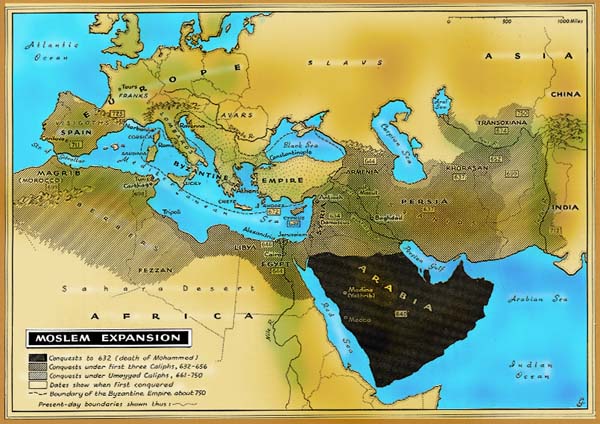
__________
Notable Islamic Contributors to New Knowledge |
Al-Khwarizmi |
Baghdad |
mathematician
|
|
(Ali ibn Sina) |
Bokhara |
physician
|
Averroes |
Cordova |
philosopher
|
|
|
|
Ptolemy's treatise...
or The Mathematike Syntaxis
...came to be known as... or The Megiste Syntaxis
...which the Arabs transliterated as al-Majisti. |
|
|
|
|
Abu Abdullah Al-Battani (858-929)
|
|
al-Mahani (b. 860)
|
|
Abd al-Rahman Al-Sufi (903-986)
The constellation Sagittarius as it would appear to an observer examining a celestial globe. |
|
Abul Wafa Muhammad al-Buzjani (940-997)
|
|
Abu Ali Hasan Ibn al-Haitham (Alhazen) (965-1040)
|
|
Abu Raihan al-Biruni (973-1048)
|
|
Nur al-Din Ibn Ishaq al-Bitruji (Alpetragius)
(d. 1204)
|
|
Nasir al-Din al-Tusi (1201-1274)
Page from al-Tusi's Memoir on Astronomy. "Tusi couple" is illustrated on right-hand page. |
|
Ala al-Din Abul-Hasan ibn Al-Shatir (1304-75)
|
|
Ulugh Beg (1394-1449)
The Fakhri sextant at Ulugh Beg's observatory is a 60° arc of stone with a 40 m radius. Because of its large size, observers could measure star positions with a very high precision. Many scholars were attracted to work and study at the observatory from 1420 to 1437. |
 |
|
|
|
Star names:
|
|||||||||||||||||||||||||||||||||||
|
|
|
|
|
|
|
| Vitruvius | On Architecture | written in Latin |
|
| Al-Khwarizmi | Arithmetic
Trigonometry Algebra |
Adelard of Bath/Arabic
Adelard of Bath/Arabic Robert of Chester/Arabic |
|
| Al-Kindi | Perspective | Gerard of Cremona/Arabic |
|
| Alhazen | Optics | translator unknown/Arabic |
|
| Avicenna | The Canon on Medicine | various translators/Arabic |
|
| Averroës | commentaries on Aristotle | Michael Scot/Arabic |
|
| Leonardo Fibonacci | Book of the Abacus | written in Latin |
|
| Hippocrates | various treatises | various translators/ Greek & Arabic |
|
| Aristotle | various treatises | various translators/ Greek & Arabic |
|
| Euclid | Elements
Optics |
Adelard of Bath/Arabic
unknown translator/ Greek and Arabic |
unknown |
| Archimedes | complete works | William of Moerbeke/Greek |
|
| Hero of Alexandria | On Air
On Reflection |
unknown translator/Greek
William of Moerbeke/Greek |
13th c |
| Galen | various treatises | various translators/ Greek & Arabic |
|
| Claudius Ptolemy | Almagest
Optics |
Gerard of Cremona/Arabic Eugenius of Palermo/Arabic |
|
|
|
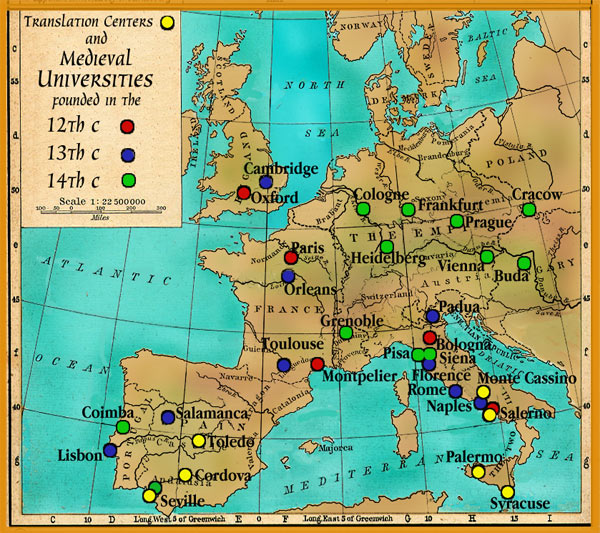
Universities:
|
||
|
|
|
Greatest happiness comes from contemplation of knowledge already derived.
"By doubting we come to inquiry; by inquiring we perceive the truth."--Peter Abelard (1079-1142)
"You will find more in forests than in books. Woods and stones will teach you more than any master."--St. Bernard of Clairvaux (c. 1090-1153)
|
The telescope is a relatively modern invention. Before 1610, the naked eye was the only optical instrument available to skywatchers. Pre-telescope astronomers, navigators, surveyors, calendar makers, and timekeepers made use of a variety of other tools that evolved so gradually over such a long period of time that we cannot identify their origins. Instruments like the astrolabe, alidade, cross-staff, quadrant, and sextant were all designed to guide the observer's eye along a particular line of sight to a target object thus enabling him to measure its position compared to some point of reference. Knowing these positions with some confidence was key to determining local time and/or position, and creating accurate celestial and terrestrial maps.
One man holds a quadrant while another sights the eclipsed
sun. An assistant tracks the time with a portable sundial.
Student navigators practice using the cross-staff. |
|
|
A modern illustration depicting the universe described
by Dante Alighieri (1265-1321) in his Divine Comedy (1306-1321)
The universe depicted in The Nuremberg Chronicle (1493) |
|
|
Sacrobosco (? - 1256)
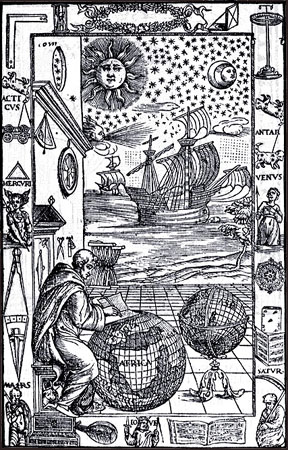
Sacrobosco writing (literally) "On the Sphere", from a 1537 edition of Sphæra Mundi. |
| The small drawings within the border of the illustration seen above show the
planets: Mars (lower left corner), Mercury (center left), Venus (center
right), Saturn (lower right corner), and Jupiter (center bottom).
In the border at the top are instruments for measuring space: square (upper left corner) and diopter (upper right corner); and for measuring time: hourglass (left of center) and pocket sundial (right of center). Scattered around the border are icons representing other mathematical studies including music and perspective drawing. Also shown are symbols for the celestial poles: "Acticus" (upper left, should read "Arcticus") and "Antar" (upper right, abbreviation for "Antarcticus". These are accompanied by small drawings of Ursa Major. On the wall behind Sacrobosco hang his observing instruments (quadrant and astrolabe) and his drafting tools (compass and square). |
Even if readers could not understand all or most of the text, they could learn from studying the book's many illustrations.
Explanation of lunar (top drawing) and solar (lower drawing) eclipses, from a 1491 edition of Sacrobosco's Sphæra Mundi Later editions included movable illustrations called volvelles which readers could turn to better understand changing celestial phenomena.
A volvelle from a 16th c edition of Sphæra Mundi that illustrates a lunar eclipse. |
Georg Peurbach (1426-1461) initiated the challenging task of translating the Almagest directly from Greek into Latin. After Peurbach's untimely death, the project was carried out by his pupil, Johannes Müller of Königsberg (1436-1476), who was known by his latinized name, Johannes de Regiomontanus (Königsberg, or King's Mountain). The book, The Epitome of Ptolemy, published in 1496:
|
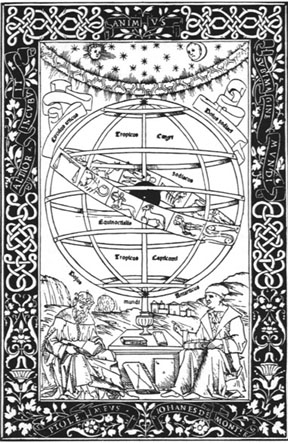
Frontispiece from The Epitome of Ptolemy (1496) shows Ptolemy (left) reading from the Almagest while Regiomontanus listens attentively (right) and points to the well-ordered celestial scheme that Ptolemy's great work describes. |
|
Gerard of Cremona's Latin translation of Almagest from 1175 appeared in print in 1518. The first edition of Almagest in the original Greek was published in 1538. |
|